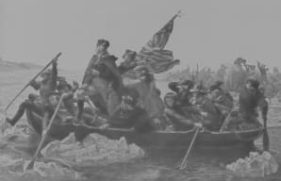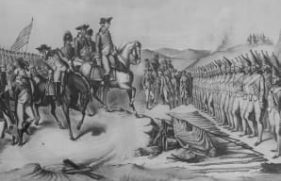
Washington Crossing the Delaware
Revolution and the New Nation (1754-1820s)
A National Archives Foundation educational resource using primary sources from the National Archives

Published By:
Historical Era:
Thinking Skill:
Bloom’s Taxonomy:
Grade Level:
This activity can be used to teach the importance and impact of the Battles of Trenton and Princeton in the Revolutionary War. For grades 4-8. Approximate time needed is 45 minutes.
By the end of this activity, students should be able to:
To begin, open the activity and display the map, “Plan of the Operations of General Washington against the King’s Troops in New Jersey.” Direct students to look carefully at the map and model map analysis for them:
Discuss their findings. Ask volunteers to point out the following places on the map: New Jersey, Pennsylvania (only partially visible), the Delaware River, Trenton, Prince Town (Princeton). Ask for volunteers to locate the red bars and the yellow bars on the map. Explain that red represents British Troops and the yellow represents the Continental Army. Ask students to identify and share any additional information they see on the map. Once students are familiar with the map, they can begin the activity independently.
If necessary, share background information (provided below) about the Battles of Trenton and Princeton. In addition, you can “meet” General George Washington in a recorded program on the National Archives YouTube channel.
Students may work on their own, in pairs, or in small groups to complete the activity of pinning the documents and descriptions to the correct blue dots on the map. Each blue dot will be matched to one image and one related description. Students should examine each image and search for clues that help match it to the appropriate description and location. Explain to students that the images are copies of paintings and lithographs that were created decades after the events and were compiled as part of the George Washington Bicentennial Commission and/or by the Commission of Fine Arts.
Model careful document analysis for each of the images.
After students have finished moving the images and descriptions to the map, review their responses. Lead a class discussion on the impact of the victories at Trenton and Princeton on the American Revolution.
Then direct students to click on “When You’re Done,” where they will be presented with the following writing prompt:
Closely examine the original painting Washington Crossing the Delaware by Emmanuel Leutze (from The Metropolitan Museum of Art). Choose one of the people in the first boat in the painting.
Background Information on the Battles of Trenton and Princeton
A little more than a year and a half after the “Shot Heard Round the World” at Lexington and Concord started the American Revolution, and less than six months after the Declaration of Independence, the Continental Army was in a perilous position in the winter of 1776. Victories for General Washington and the Continental Army were few and far between. In the words of Thomas Paine in his famous treatise The Crisis, these were “the times that try men’s souls.” With recruitment dwindling and enlistments set to expire at the end of the year, General Washington would have to execute a bold strategy to regain the momentum and turn the tide.
Washington and the Continental Army were in Pennsylvania after having retreated following the stinging defeat at the Battle of Long Island and subsequent battles through the summer and fall of 1776. Washington planned a surprise three-pronged crossing of the Delaware River. On the night of December 25, 1776, Washington successfully led his army of 2,000 cold, tired, and hungry soldiers across the ice-choked Delaware at McConkey’s Ferry. Once on the New Jersey side, they marched ten miles to Trenton in a blizzard arriving at Trenton at about 8:00 a.m.
The attack took the garrison of Hessian soldiers (German soldiers hired by the British military) completely by surprise. The Continental Army won an overwhelming victory capturing more than 900 prisoners and taking much needed guns and ammunition. No Americans were killed in action and only five were wounded. The Battle of Trenton was one of the most significant victories of, and a turning point in, the Revolutionary War.
One day later on December 27, General Washington and the Continental Army again crossed the Delaware River to New Jersey and decided to defend Trenton from the British and Lord Cornwallis. On January 2, 1777, Cornwallis, with 8,000 British and Hessian troops, attacked the 6,000 members of the Continental army at the Battle of Assunpink Creek (also known as the Second Battle of Trenton). Washington and his army successfully repelled Cornwallis’s forces.
Rather than continuing the battle, Cornwallis withdrew for the night, determined to finish off the American army the next day. Washington and his senior officers agreed to another bold and dangerous plan. With campfires burning as a distraction, Washington and the Continental Army left Trenton, sneaked around Cornwallis and marched the 18 miles north to Princeton on a bitterly cold night. On January 3, 1777, the Continental Army attacked and defeated the British, pushing them out of New Jersey. Washington and his troops moved to Morristown, New Jersey, where they established winter quarters and prepared for the spring campaign.
The victories at Trenton and Princeton (known as the “Ten Crucial Days”) had several important results for the Americans. It put new life into the American cause, renewed confidence in General Washington as the commander, helped recruit additional forces to continue the war, and erased the idea that the British couldn’t be beaten. The victorious battles strengthened the claim of American independence.
In this activity, students will examine a map of General Washington’s campaign against the British in New Jersey from December 25, 1776, to January 3, 1777, during the Revolutionary War. They will match descriptions and images of the events to the correct locations on the map.



